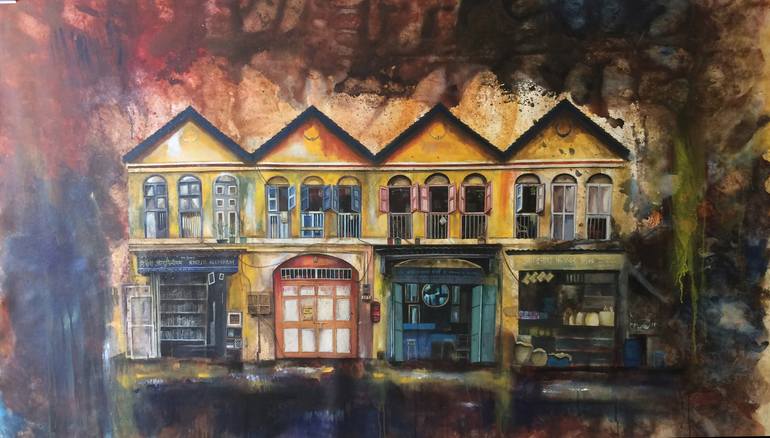







VIEW IN MY ROOM
Lower Parel Painting
India
Painting, Acrylic on Canvas
Size: 80 W x 48 H x 0.1 D in
Ships in a Tube
Shipping included
14-day satisfaction guarantee
About The Artwork
Lower Parel is a crowded, bustling area of Mumbai. Originally made of tenements and sprawling buildings which housed several families in tiny two room homes. Due to overcrowding, the distinction between home and street was blurred; residents spent more of their time on the street than in the home. The occupants were mainly textile mill workers, who had come here from their villages outside Mumbai, looking for work. The mills of the early 1900s gave them plenty of opportunity. But change is the only constant, and the mills started closing down in the 1980s, after the Great Bombay Textile strike. Slowly, work dried up. After the strike, people returned to their villages or went looking for other work. The ones who were lucky found new jobs. Despite the overall hardship, I love the vibrant atmosphere here. It's full of small businesses like tea shops, bakeries, newspaper shops, beauty parlours, flour mills, liquor stores. A Sunday morning walk here always leaves me hopeful and energised. The hardworking and industrious nature of Mumbai is seeped in these old walls and homes. This is a little slice of real Mumbai.
Original Created:2020
Subjects:Architecture
Materials:Canvas
Styles:ImpressionismExpressionism
Mediums:Acrylic
Details & Dimensions
Painting:Acrylic on Canvas
Original:One-of-a-kind Artwork
Size:80 W x 48 H x 0.1 D in
Frame:Not Framed
Ready to Hang:Not applicable
Packaging:Ships Rolled in a Tube
Shipping & Returns
Delivery Time:Typically 5-7 business days for domestic shipments, 10-14 business days for international shipments.
Handling:Ships rolled in a tube. Artists are responsible for packaging and adhering to Saatchi Art’s packaging guidelines.
Ships From:India.
Customs:Shipments from India may experience delays due to country's regulations for exporting valuable artworks.
Have additional questions?
Please visit our help section or contact us.
I was born in a place in south west India, close to Goa. My father was an agriculturist and social worker, and my mother was an author. I was lucky to grow up in a forest. My father and I walked the dogs in the woods and fields everyday whenever I was home. I spent a great deal of my time away, leaving my parents at the age of five to go away to school. A lifetime of boarding schools and hostels followed. But every long weekend and vacation was at home, much looked forward to. I grew up to love the forest, its peace, tranquility, its ways and quiet joys. I had always loved to draw, starting even before I could write. Scribbling and doodling were never frowned upon in my childhood, and my parents encouraged my art. Eventually, I became an art director. Working in advertising agencies taught me many things, and I had a rewarding career of 14 years. I left when we were financially settled, and now am fortunate to paint almost full time. I teach twice a week, and paint the rest. I paint what I care about - my city (Mumbai), the people who live here, the tropical forest I grew up in, childhood memories. I find my work takes two routes - one is to paint the city and people, and the other is to paint the forest. I guess my father's influence of agriculture and socialism are responsible for these divergent ways. I have been exhibiting since 2013, and have been fortunate to have my work shown in Dubai, Paris, Qatar. My work has been bought by collectors from the UK, US, Dubai, New Zealand and India. I also undertake commissioned work and murals. www.menamalgavkar.com
Thousands Of Five-Star Reviews
We deliver world-class customer service to all of our art buyers.
Global Selection
Explore an unparalleled artwork selection by artists from around the world.
Satisfaction Guaranteed
Our 14-day satisfaction guarantee allows you to buy with confidence.
Support An Artist With Every Purchase
We pay our artists more on every sale than other galleries.
Need More Help?